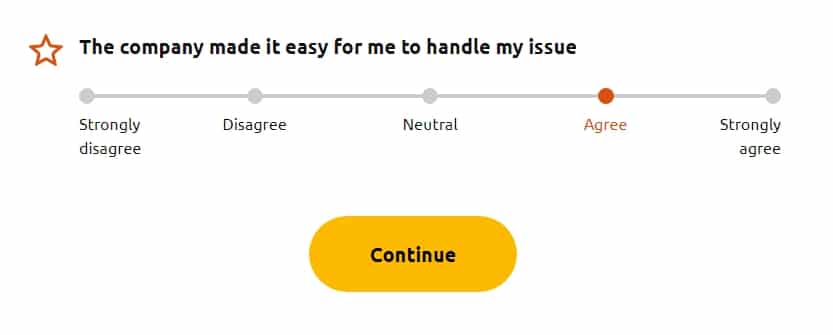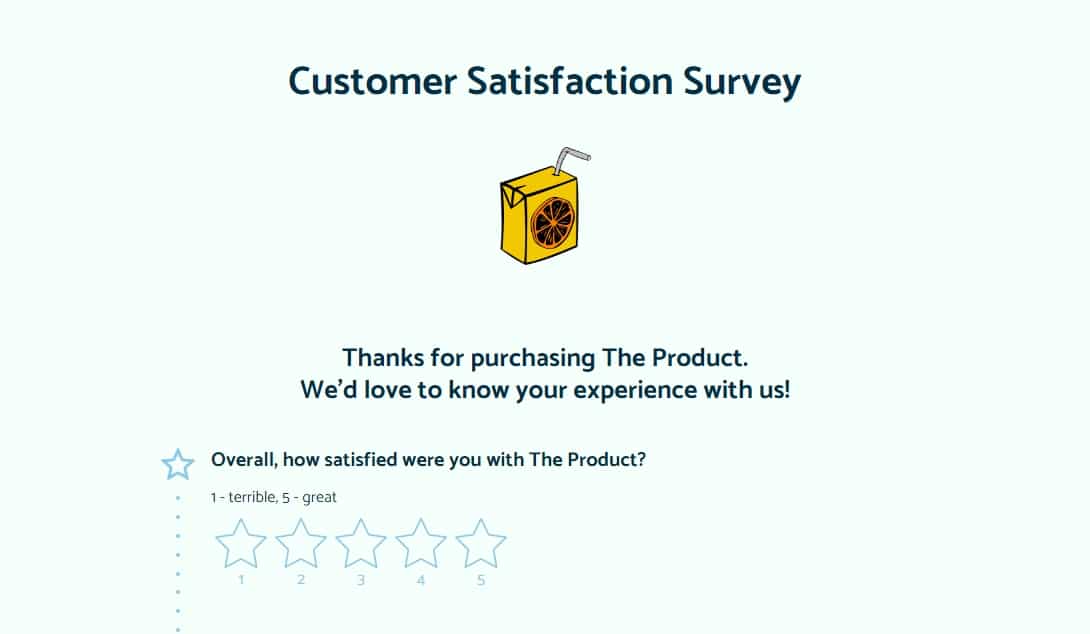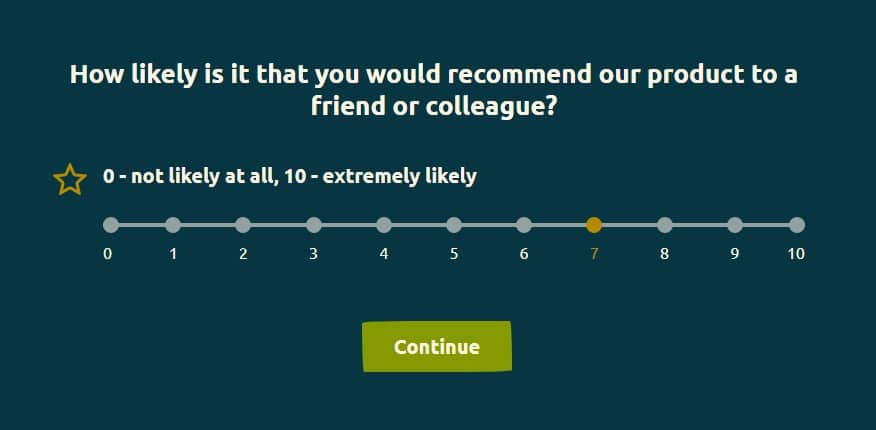Satisfied customers are what makes your business a success. Sounds like Marketing 101, but making your customers love what you do is not an easy task! Whether you’re a local or global company, doing customer surveys regularly is key to being on top of what people want. Feedback helps you improve your products and services as well as get valuable insights for your ongoing marketing activities. If you ask the right questions, you can even figure out what new products and services your customers are willing to buy – and plan accordingly.
Customer Surveys You Should Use (and Why)
All of these are extremely useful for market analysis and decision-making. Let’s get into some detail about each of those metrics.
Customer Effort Score (CES)

Customer Effort Score shows how easy it is for the client to interact with a company in a particular situation. How easy was it to place an order, subscribe to a newsletter or use the software? Asking questions about the ease of use helps to find pain points in the overall customer experience and fix them. Paying attention to CES helps you simplify the client’s interaction with the company.
The story behind the invention of this method is curious. CES was developed by the Corporate Executive Board Company (CEB) based on their research, specifically on 4 insights about how service affects customer loyalty. These conclusions are:
- Inflated customer expectations are not profitable and do not increase loyalty, instead of overhyping your product and failing to deliver it’s better to meet customer expectations;
- There is no apparent correlation between satisfaction and loyalty: a satisfied customer is not necessarily a loyal one;
- If a customer needs to contact customer service (because they can’t solve a problem on their own), the chance of their loyalty decreasing is 4 times higher;
- The key to increasing loyalty is to make sure that the customer solves their problem with minimum effort.
We recommend reading an excerpt from “Shifting the Loyalty Curve. Mitigating Disloyalty by Reducing Customer Effort” from Corporate Executive Board for more information on CES.
The classic Customer Effort Score question is “How much effort did you personally have to put forth to handle your request?” with a five-point scale from “very little” to “very much” for evaluation.
Customer Satisfaction Score (CSAT)

Customer Satisfaction Score highlights another facet of customer experience: not the effort required in the process of interaction with your company, but the satisfaction with the result. Like CES, this method evaluates customer experience during a specific interaction rather than the relationship with the company. For example, you can use CSAT to find out if the customer liked the website, delivery, product or service, customer support, and so on. It’s one of the most widely used evaluation methods in online marketing.
A quick tip: Hubspot recommends using CSAT to measure satisfaction at multiple points in the customer’s journey. Satisfaction surveys can be very short and easy to fill out so be sure to ask for feedback any time you have the chance. This way, you’ll learn how different stages of the journey feel to your customers. Measuring satisfaction helps you find potential bottlenecks and improve service quality.
The basic CSAT question is “How satisfied are you?”. You can use anything between a 3-point to a 10-point scale for evaluation – there is no industry standard on that.
Net Promoter Score (NPS)

Net Promoter Score is a customer loyalty index that helps you learn how customers feel about your company in general. Unlike CES and CSAT, the loyalty index does not measure the results of a single interaction but instead evaluates the entire customer experience with the company. For example, CSAT can show whether the customer is satisfied with a support call, with NPS you measure customer loyalty to your brand.
This loyalty index was developed at Bain & Company and promoted as a metric that all companies should use. The author of the concept, Frederick Reichheld, advertised NPS as something incredible in his study “The One Number You Need to Grow”. NPS was introduced in 2003, and by 2011 it had transformed from a straightforward loyalty evaluation metric into a methodology for business management that helps companies identify and solve problems, increase their profitability and develop marketing strategies. Now, NPS is one of the most well-known methodologies in its segment.
The basic Net Promoter Score survey may consist of just one question: “How likely is it that you would recommend our company/product/service to a friend or colleague?” With the scoring on a scale from 0 (Not likely at all) to 10 (Extremely likely).
These are the three key metrics for evaluating customer experience and the basic survey questions you can use to measure them. If you already have an idea of a survey you want to start with, you’ll need a survey maker to create your questionnaire – use AidaForm or other similar online survey builders. Services like that are easy to use, have custom designs to choose from, and come free as long as you don’t have very specific needs or a large database of respondents.
Not sure where to start yet? Keep reading – there are more great ideas below!
4 Practice Tips: Integrate Сustomer Surveys in Your Marketing Decision-Making
- Find out how your product has helped your current users
Choose the most interesting answers and write creative use cases and customer success stories. Publish them on your website to use for content marketing – distribute use cases via email, your social networks, and guest posts on other platforms. Don’t forget to ask people for users’ written consent before you publish their stories though to avoid legal issues.
- Ask your existing customers what they don’t like about your product
Take criticism into account and make improvements! Keep in touch with customers who criticize you – even if you can’t make them stay, improving your product or service will help you gain new customers. Plus, people will be more willing to give positive feedback about your business in the future if you meet them halfway and solve their problems.
- Get to know what people like about your product or service
Focus on these aspects in promotional copy and content on your website. Chances are – many other people are looking for similar things when they’re searching for a product or service like yours. Ask your loyal customers to write reviews on review platforms and create an “Our Users Say” section on your website. As long as you get the reviews privately, make it explicit that you want to publish them and ask for consent from your users.
- Learn about your users’ major problems right now
Collecting information about user pains is where a customer survey meets customer development. Analyze responses, conduct additional research and in-depth interviews to mitigate and solve your customers’ main problems and expand the scope of your services.
When you do customer development, do it the right way! If you want to know what problems users have, ask them only about their actual prior experiences. Avoid asking existing customers if they would ever buy a hypothetical product you don’t offer. Ask about their current pain points and try to find out if the product or service you plan to launch will solve those problems.
How To Actually Get Feedback When You’re Asking
- Send emails to your existing customers and ask for feedback. Include a link to the survey form in the email.
- Write posts in your social media accounts asking your customers to help you improve and add the link to the survey form to your posts.
- Be positive and honest about what you’re gathering feedback for: explain to your users what’s in it for them – and they’ll respond more actively.
- Offer small gifts or discounts to people who take their time to answer your questions as a token of your gratitude. In our experience, doing that increases the number of responses up to 10 times!
The post From Customer Satisfaction Surveys to Informed Online Marketing Decisions – Examples and Tips appeared first on Tweak Your Biz.
No comments:
Post a Comment